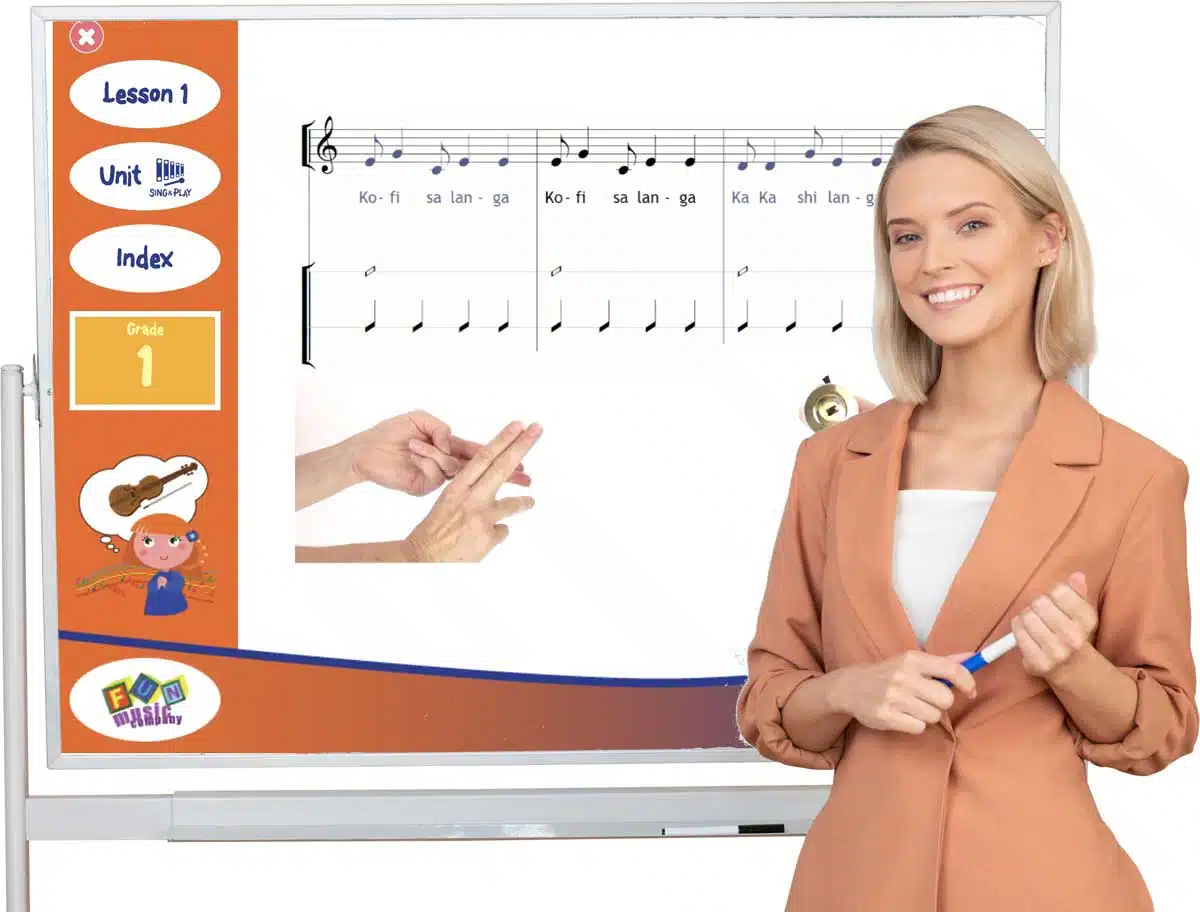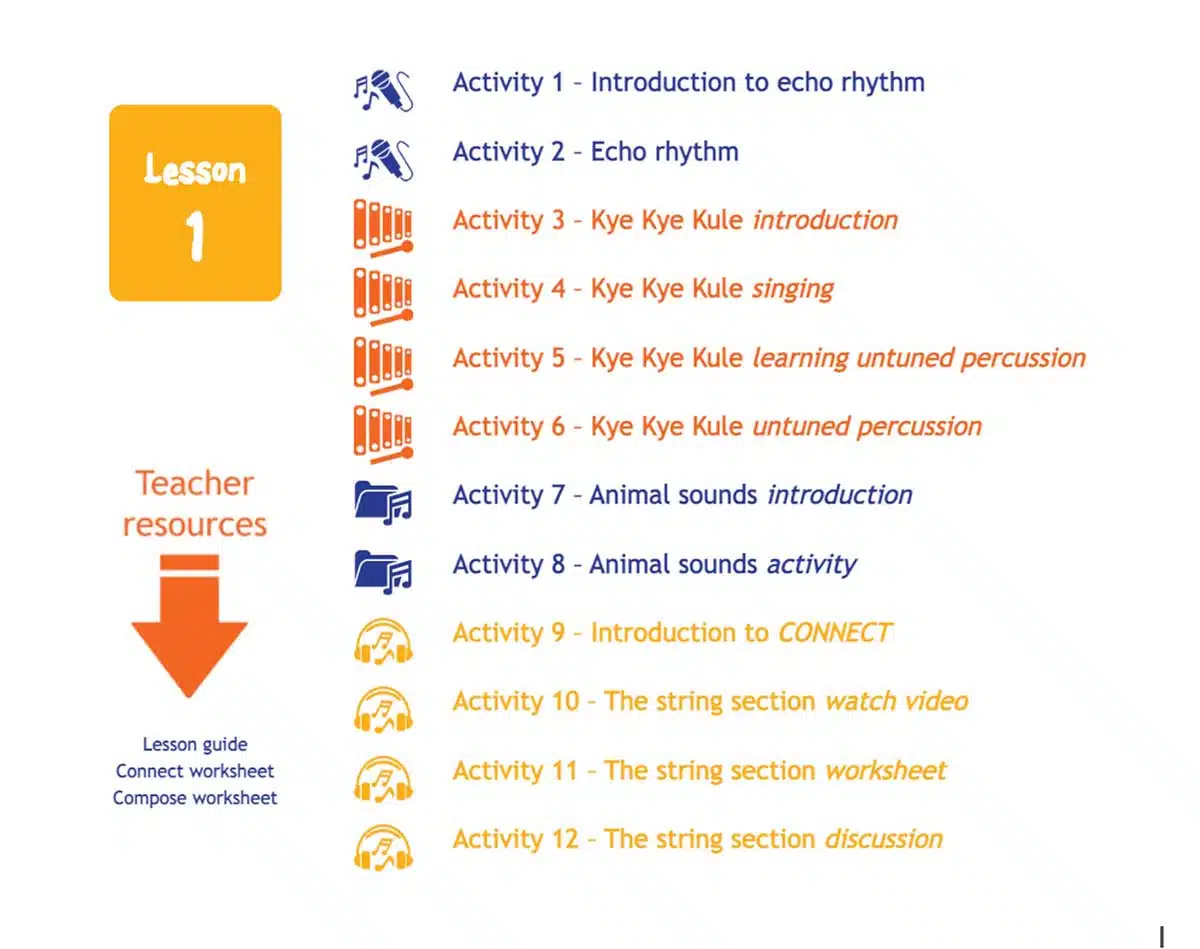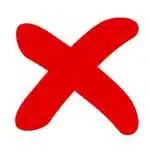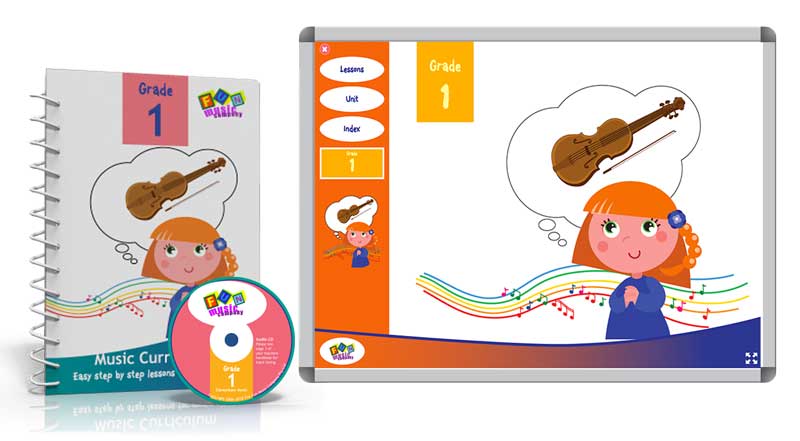Teaching grade 1 music lessons?
This article gives an overview of a typical grade 1 music lesson plan. Then it shows you how it can be implemented.

Creating a lesson plan to teach grade 1 music lessons
Creating a music lesson plan is difficult enough!
Getting a lesson to fit curriculum requirements is even harder!
Firstly, you need a clear sense of the curriculum requirements. Then you need to turn it into an enjoyable lesson for your students.
What is the purpose of a lesson Plan?
Any lesson plan is a simple list of activities. It should also have an idea of where it fits into your program.
It needs to be easy to read, so you can glance at it and be ready to teach. It can also act as a reference to hand on to a substitute teacher.
Personally I like to plan by creating a list of links on my computer. That way every resource I will need will only be one click away!
Here’s an example of a first grade lesson plan:

How to prepare for grade 1 music lessons
There are only a few really important things to prepare:
What you do need and what you don’t need for teaching Grade 1 music lessons:

You don’t need massive amounts of musical skill

You don’t need hours of specialised training or conferences.

You DO need to be thoughtful and caring for grade one students.

You DO need to be prepared to have fun and be upbeat and happy.
How to create an impactful Grade 1 music lesson
Begin by structuring your lesson content around the four key content areas.
1. Skills.
Music is a more potent instrument than any other for education because rhythm and harmony find their way into the inward places of the soul.
– Plato
The idea of developing skills appears in every curriculum program. The skills worked on in grade one include:
- Keep a steady beat.
- Identifying musical sounds and non-musical sounds.
- Developing an ability to replicate a rhythm.
- Develop an idea of pitch.
In the video below I show you how to work on beat and rhythm skills. We do this with a simple echo rhythm activity.
Regularly repeat warm up activities like this one. This will cover this area of the curriculum.
This video shows you the echo rhythm activity for grade 1.
2. Singing and playing.
“A happy child is a child who sings.” – Unknown/Anonymous
Children should be involved in music making in every music lesson. This is where they develop the love and enjoyment for music. They also have fun, and enjoy being a part of their class community.
The Fun Music Company Curriculum program starts with singing. This is a foundation to move quickly into playing instruments.
Not every grade one child will want to sing. Some will sing, some will do actions. Some won’t want to do anything at all at first!
It is up to educators to provide enthusiasm and structure. This will make it safe and accessible for children to participate.
The video below has a strategy to catch the children’s attention:
- How to get them singing.
- How to get them taking part.
- How to get them ready to play instruments.
3. Creativity.
“Let music belong to everyone.” Zoltan Kodaly
What? Letting grade 1 students COMPOSE THEIR OWN MUSIC?
Actually … YES!
Suppose in an art class we gave a child a paint brush and then said:
“You can paint, but you must only use these colours. You also must exactly replicate this picture!”
This is exactly what we’re doing in music class when we say:
“Here is how to perform three blind mice on the piano”
There is no creativity in this type of lesson. It is replicating what someone else has done before.
In art lessons for Grade 1 we would not do that! We would give them a blank sheet of paper. We might prompt the students with an idea, and then we would let them create. Anything they created we would praise and reward.
So in music we need to re-think our approach. We must encourage children to create their own music, within set frameworks.
Most teachers aren’t trained in the area of composition. Most teachers aren’t composers, however you don’t need to be.
Just follow some simple ideas like this one.
4. Listening and connecting.
“How beautiful would it be if our schools and our education program showed how music is a combination of many different cultures, and cultures are an expression of many kinds of music? There’s a lot for our students, not only from a musical perspective, but also from a global perspective and in showing them how they fit in as part of a bigger world.”
– Dr. Miguel Cardona, U.S. Secretary of Education (Source: NAfME interview, July 2021)
Music is a way to expose our children to cultural experiences. This is extremely important.
Children should listen, but not just listen. They should analyse, respond, and express preferences.
The CONNECT part of a music lesson provides a listening experience. It also helps them understand and connect with music and its purpose.
The Australian Curriculum for Grade 1 states that students should:
“Respond to music and consider where and why people make music.”
The US Common Core Arts Standards states that students should:
“Demonstrate and identify how music concepts are used in various styles of music.”
This means we should have students listen to a wide variety of music. This music should be from different cultures and backgrounds. Students should understand its specific purpose, and not just listen to it.
Children at grade one don’t have to write essays. Just begin with a simple listening activity and worksheet.
Making it all easy …
This all seems like a lot of work, doesn’t it!
That is why we’ve taken the hard yards for you. We have created a complete music curriculum program for grade 1.
This program has everything needed to be successful in teaching grade 1 music. Fun songs, games, creativity lessons and listening activities. All structured in a series of lessons you can prepare in an instant.
Designed for the curriculum, so you can focus on the children. Click here to learn more about it.



Leave A Comment